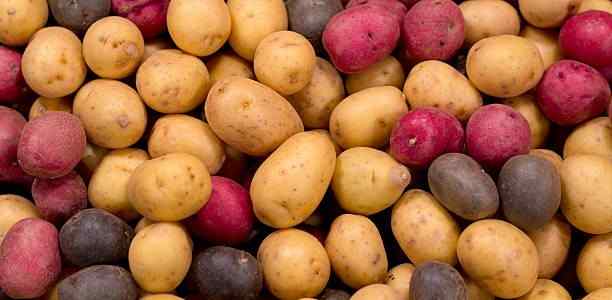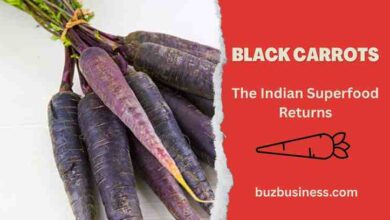The Potatoes Revolution: India’s Golden Crop

India is by far the second largest potato producing country in the world, behind China. This simple root vegetable has gone from newcomer to an Indian agricultural and culinary staple. Potatoes have all but become a native veg, grown from the Gangetic plain of Uttar Pradesh to the riverine tracts of West Bengal, and feeding and employing millions in between.
The History of Potatoes in India
The potato came to Indian soil with Portuguese sailors in the early 17th century. Initially introduced in coastal regions, the British later spread it to North India. What was a foreign novelty has over the centuries become what many Indians call the “King of Vegetables”.
This wasn’t immediate. The potato faced resistance as it was unknown to local taste buds and farming practices. But its adaptability, nutrition and high yield won over farmers and consumers.
Since 1961 potato production in India has grown over 20 times, it is the fastest growing staple crop in the country. Today it is the 4th most important food crop in India after rice, wheat and maize and plays a big role in national food security.
India’s Position in Global Potato Production
India is the second largest producer of potatoes in the world next to China with an annual production of 59.74 million metric tons. This product value is about 12% of the world production of potatoes that shows the importance of India for the world food security.
Potato cultivation is spread across various agro-climatic zones from the Himalayas to the coastal plains. This allows for year round production with different regions harvesting at different times based on local climate.
India’s position in potato production is all the more remarkable since the crop is not native to the subcontinent. The successful integration of potato in Indian agriculture shows how adaptable is the crop and the Indian farming community is.
Top Potato-Producing States in India
Uttar Pradesh: The Potato Titan
Uttar Pradesh leads in potato production with 15.89 million tonnes. The state’s vast, fertile plains at the Gangetic belt make for ideal potato growing conditions. Main production districts are Agra, Farrukhabad and Meerut where generations of farmers have perfected the art of potato cultivation.
Coupled with well developed irrigation infrastructure, established seed production systems and strong marketing linkages, the state ranks first in producing potatoes. Potatoes are rotated with other crops by most farmers in Uttar Pradesh, usually as a post-rice crop.
West Bengal: The Eastern Powerhouse
Close behind is West Bengal, which produces 12.6 million tonnes of potatoes annually. The alluvial soil in the state, especially in the Hooghly, Burdwan and Bankura districts is ideal for producing quality potatoes.
The potato industry of West Bengal also benefits from the fact that it has an organized infrastructure of a cold storage system that is meant to deal with the seasonal nature of the production. Specialized potato markets have also been established for easier distribution throughout eastern India and in neighboring countries.
Bihar: Rising Potato Producer
Bihar is third, producing 9.13 million tonnes a year. Potato production in the state has also increased with the use of high-yielding varieties and better agricultural practices. Nalanda and Purnia districts have become prominent potato-producing areas for the state.
Bihar, meanwhile, has become a potato powerhouse, with enhanced technology and irrigation helping with yield as well as quality.
Other Major Contributors
Gujarat produces 37.8 lakh tonnes per annum, employing innovative irrigation practices in areas such as Banaskantha. Madhya Pradesh contributes 3.58 million tonnes, where varied agro-climatic conditions provide longer growing seasons, especially in the regions surrounding Indore and Ujjain.
Though better known for their grain production, Punjab produces 2.85 million tonnes of potatoes annually, with Haryana producing 765,900 tonnes. Assam, in the northeast, ranks at 761,840 tonnes and nascent producers of Jharkhand and Chhattisgarh at 733,770 and 623,650 respectively.
Cultivation Practices and Varieties
In India, over 300 types of potatoes are produced, which are adapted to different uses and climatic conditions. These can be characterized as falling into the types:
Table Varieties are cultivated for consumption purposes, and thus they should have good flavor and cooking quality. Kufri Jyoti and Kufri Chandramukhi are popular examples.
Processing Varieties: These are grown specifically for industrial processing into chips, fries, and other products. These types generally have high dry matter and low reducing sugars. A good one is Kufri Chipsona.
Seed Cultivars: Grown under rigorous disease-control conditions to produce seed potatoes for subsequent crops.
The Indian agricultural research system and particularly the Central Potato Research Institute (CPRI), has developed a number of improved varieties for Indian conditions. They provide advantages in terms of resistance to diseases, yield, and adaptation to a particular area’s climate.
The cultivation practices vary per region but generally involve:
- Deep plowing for land preparation
- Planting in ridges and furrows
- Proper and regular irrigation management
- Integrated management of pests and diseases
- Proper fertilizer application
- Harvest 70-120 days after planting
Nutritional Value and Health Benefits
Potatoes are often criticized as “empty carbs,” but they are actually quite nutritious. They are also loaded with nutrients beneficial to human health:
Rich Vitamin Content
Potatoes are also very high in vitamin C, with a medium-sized potato supplying about 45% of daily needs. This vitamin is important for immunity, collagen synthesis, and as an antioxidant. They are also high in vitamin B6, which is important for brain development and function.
Mineral Powerhouse
In fact, potatoes are higher in potassium than bananas; a medium potato has approximately 20 % of the daily value. Potassium is important for regulating blood pressure and supporting normal heart function. They also supply magnesium and phosphorus, as well as trace iron and zinc.
Quality Carbohydrates
The carbohydrates given off in potatoes are mainly starches which are complex and offer slow energy. Potatoes, eaten with the skin, supply around 4 grams of fiber per serving and are therefore good for digestion and helping one feel satisfied or full.
Health Benefits
There are health benefits associated with including potatoes regularly as part of a healthy diet:
Cardiac Health: High in potassium for blood pressure management, and high in fiber for cholesterol management.
Promotes Digestive Health: Raw or cooled potatoes contain resistant starch, which functions as a prebiotic that feeds positive intestinal bacteria.
Blood Sugar Control: Potatoes, when cooked and consumed with other foods, have a medium glycemic index, rather than a high one, as many believe.
Antioxidant protection: Colored kinds promote the production of anthocyanins, particularly in the case of purple and red potato varieties, which help to fight oxidative stress.
Immune Benefits: Supports the immune system and helps protect against common illnesses due to the presence of vitamin C.
Of course, how potatoes are prepared can greatly influence their nutritional content. Deep-frying also doesn’t preserve nutrients as well as boiling or baking potatoes with the skin on.
Potatoes in Indian Food
Potatoes have become an integral part of various regional cuisines in India. From street food to home cooking, potatoes are a part of many favourite dishes:
North Indian
In North India, potatoes are the star of the show in aloo paratha (stuffed flatbread), aloo gobi (potato and cauliflower curry), and dum aloo (baby potatoes in rich gravy). The famous street food samosa has a spiced potato filling in a crispy pastry.
South Indian
South Indian cuisine has potatoes in masala dosa (crepe with spiced potato filling), potato varuval (dry curry) and potato stew with appam (rice pancakes).
East Indian
In Eastern India, especially in Bengal, aloo posto (potatoes in poppy seed paste), aloo bhaja (crispy potato fry) and aloo dum (pressure-cooked potatoes) are household items.
Western Regional
Western Indian cuisines have potatoes in batata vada (potato fritters), pav bhaji (mashed vegetable curry with potatoes) and Gujarati dishes like batata nu shaak (spiced potato curry).
In India, we say “like an aloo” to mean someone who fits in everywhere, because potatoes are such an integral and universal food item that they transcend regional cuisines. Potatoes help a meal go further, they lend body to vegetable dishes and are a source of comfort all classes and castes, indeed, all of society, not limited to just India.
Economic Impact and Export Potential
The potato sector is a major component of India’s agricultural economy, providing farmers with a large source of income as well as jobs across the value chain. Potatoes engage millions of people in India from the field, through the processing, transport, storage and market.
Export Landscape
In 2022, India was the 12th largest potato exporting country in the world, with approximately US$108 million of potatoes exported to over 30 countries.
Main export destinations are:
- Neighboring Countries: Nepal, Sri Lanka and Bangladesh
- Middle East: Oman, Saudi Arabia and UAE
- Southeast Asia: Malaysia and Indonesia
Although they are present in international markets, Indian exports of potatoes represent a very small portion of the total production and there is huge scope for growth. Some of the challenges for growing exports are quality standards, phytosanitary aspects and competition by other major global exporters.
Processing Industry
India’s processed potato industry has grown tremendously and is now worth more than Rs. 30,000 crore. Some major products are:
- Potato chips and crisps
- French fries
- Dehydrated potato products
- Potato starch
- Frozen potato preparations
Major food companies have their own factories to process potatoes, thus providing a guaranteed market for farmers who grow certain processing varieties. Nonetheless, this also represents under 10% of the country’s total potato production, which is considerably lower than the 30-40% global average for processing.
Cold Storage Infrastructure
India is among the top nations endowed with good storage capacities for potatoes due to the large number of facilities located in major potato-producing states. The infrastructural support serves in managing the crop season and reducing post-harvest losses quite significantly. A temperature range of 8-12°C and relative humidity are maintained in present-day cold storage godowns so as to prolong the shelf life of potatoes by many months.
Establishment of this cold storage network played a great role in stabilizing potato prices all through the year, which was beneficial to the producers and consumers. Regrettably, this is not replicated in rural areas, where access to cold storage is still a big problem and some facilities use outdated technology.
Challenges in Potato Cultivation
Despite high production, potato farmers in India face many challenges:
Disease and Pests
Late blight disease caused by Phytophthora infestans can destroy entire fields in just days. Other diseases are early blight, bacterial wilt and various viral diseases transmitted by aphids and other vectors.
The most common explain pest pressures are potato tuber moth, cutworms, and aphids. These threats can be controlled through the use of resistant varieties, crop rotation, timely application of fungicides and good agronomic practices.
Climate Change Impacts
Climate shifts can lead to increased difficulties for the growing of potatoes:
- Rainfall that cannot be anticipated causes problems with timing of planting
- Increases in temperature diminish yields and quality
- Higher incidence of disease and pests
- The increasing frequency of extreme weather events
Research organizations are working to produce heat tolerant, drought resistant seeds to enable farmers to adapt under these new climate conditions. Other measures, such as climate-smart agriculture, through more efficiency in irrigation systems as well as in the soil, are also being encouraged.
Market Volatility
Potato prices in India are highly volatile, with huge fluctuations between surplus and scarcity. This price volatility affects farmer incomes and investment decisions. Better market intelligence systems, farmer producer organisations and direct market linkages are emerging as solutions to this perennial problem.
Input Costs and Resource Constraints
Potato growers are feeling pressured in their margins due to rising costs of seed potatoes, fertilizers, pesticides, and/or labor. Another problematic factor is that in some areas water is scarce, so more efficient irrigation systems should be applied.
Innovations and Future Directions
The prospects for potato development in India are also encouraging and a number of advances will certainly lead to development in the following directions:
Technological Advancements
Precision Agriculture: GPS-guided planting, sensor-based irrigation, and drone monitoring are helping improve input use.
Tissue Culture and Aeroponic Systems: These technologies are helping to overcome a major constraint by providing disease free seed potatoes.
Digital Platforms: Mobile phone apps offering market data, pest alerts, and cultivation advice are putting knowledge in the hands of farmers.
Sustainable Practices
The potato industry is adopting sustainability more and more:
Drip and sprinkler systems are the answer to this, as they use less water at a time when you want to increase your yields.
There are, however, other techniques that can be employed by the system to make sure that pests do not bother the crop for future occurrences at reduced use of pesticides.
This demand is also of more consumers demanding organic products and this has encouraged the increase in organic potato farming.
Value-Addition Opportunities
The processing sector offers significant growth potential:
Specialty Products: Premium potato chips, frozen innovations and convenience foods are where high-value opportunities lie.
Export Market Development: Meeting the international standards requirement is a possibility for Indian potatoes to expand their export markets.
Farm-Level Processing: Commencing small-scale processing units in production clusters could be the way for farmers to improve their incomes locally.
Environmental Impact
In this sense, the cultivation of potatoes has some environmental advantages with respect to other staple crops:
- Carbon Efficiency: Potatoes take up more carbon dioxide from the atmosphere over the growth cycle than they release, making them more climate friendly than both rice and wheat.
- Water Efficiency: Potatoes produce more food per unit of water than many other crops, which is an important consideration in areas where water is stressing.
- More Food Per Land Unit: Given that potato has a high yield potential (40 tons per hectare under ideal conditions) they can generate more food out of less land.
But, more traditionally-grown potatoes also are associated with other environmental challenges such as soil erosion due to planting on sloped land, groundwater exhaustion from over-irrigation, and pollution from chemical inputs. Sustainable production is part of the solution to this problem.
Conclusion
It has been an incredible journey for the potato in India, going from an introduced, foreign crop to one that is both a staple of Indian agriculture as well as Indian cuisine. As the number two producer in the world, India’s connection to this versatile tuber is an ever growing and strengthening one.
The future for the potato in India is bright with new avenues in the areas of production, processing, and marketing. Sustainable modes of production, varieties that are adapted to climate resilience, and increasing capacities for value addition will definitely be instrumental in harnessing the “golden crop” to its full potential.
FAQs About Potatoes in India:
Q1. Which state produces the most potatoes in India?
Uttar Pradesh produces 15.89 million tonnes of potatoes every year, followed by West Bengal and Bihar.
Q2. When were potatoes introduced to India?
Potatoes were introduced to India by Portuguese sailors in 17th century, initially in coastal areas and then British helped to spread to Northern India.
Q3. What are the main potato varieties grown in India?
India grows over 300 varieties of potatoes. Kufri Jyoti, Kufri Chandramukhi, Kufri Bahar and Kufri Chipsona are some of the popular varieties. Different varieties are suited to different regions and purposes (table use, processing etc.).
Q4. How are potatoes stored in India after harvest?
Traditional storage methods include storing potatoes in cool, dry rooms with proper ventilation, often on bamboo racks or in pits. Modern large scale storage uses cold storage facilities with temperature between 8-12°C to prevent sprouting. Seed potatoes are stored at lower temperature (2-4°C).
Q5. Are potatoes nutritious?
Yes, potatoes are very nutritious. They are rich in vitamin C, vitamin B6, potassium and fiber (especially when eaten with skin). They provide quality carbohydrates for energy and have various antioxidants, especially in colored varieties.
Q6. How much of India’s potato production goes to processing?
Less than 10% of India’s potato production goes to processing (chips, fries etc.) which is much lower than the global average of 30-40%. But this sector is growing rapidly.
Q7. Can potatoes be grown throughout the year in India?
India’s diverse agro-climatic zones allow potato cultivation throughout the year, though in different regions at different times. Main season is October-November to February-March in Indo-Gangetic plains and summer in hill regions.
Q8. What are the main challenges for potato farmers in India?
Disease management (late blight), climate change, market price volatility, rising input costs and limited access to quality seed potatoes in some regions are the main challenges.
Q9. How does India’s per capita potato consumption compare globally?
India’s per capita potato consumption is 25.4 kg in 2021 which has grown from 3.45 kg in 1962 but still lower than many European countries where consumption is more than 50-100 kg per person per year.
Q10. Export potential of Indian potatoes?
India exports potatoes worth $108 million every year to over 30 countries. There is huge potential to increase exports by improving quality standards, developing export oriented varieties and accessing new markets.



